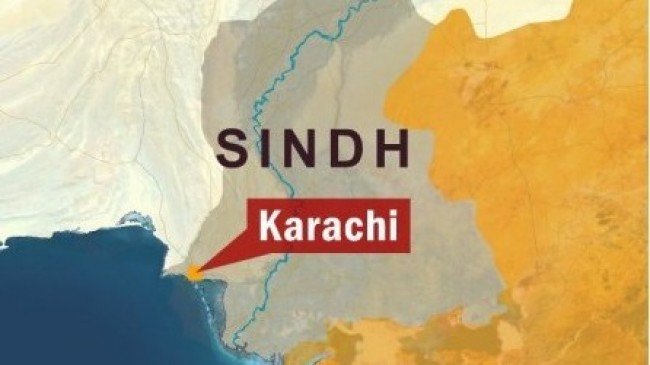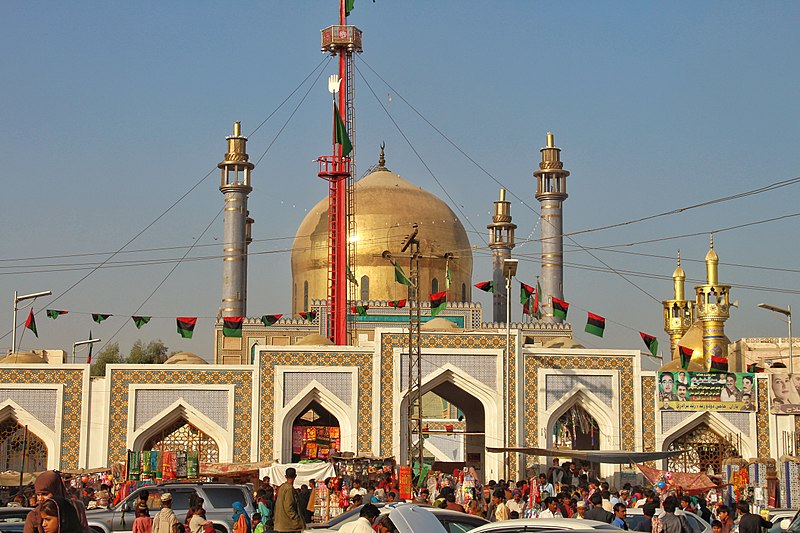
[From imperial ‘unhappy valley’, to decapitated province, commercial capital, and 21st century megacity, this article reflects on relations of separateness and connectivity between Sindh and its capital city Karachi. These culminated in Pakistan’s post-Independence years, in official and political language, governances of national, provincial and city division, and political rhetoric and violence. The article asks what else might be uncovered about their relationship other than customary alignments and partitions between an alien urban behemoth and a provincial periphery. It develops a topographical view to refer to the physical arrangement of environments but also people’s profane, spiritual and political connections and losses involving place and dwelling]
By Nichola Khan
Sufism to Jihad
Lal meri pat raki-o ballah (Lal keep me safe from evil) Jhulelaalan, Sindhari da sehwan da, Jhulelal Qalandar.
The above verse pleads for the Sufi Saint Lal Qalandar for safety from evil. The qawwal, ‘Jhulelal Qalandar’, was popularised in Karachi by the Sindhi singer Abida Parween, by Ghulam Farid Sabri of Karachi’s Sabri brothers, and by Nusrat Fateh Ali Khan whose version of ‘Dama dam Mast Qalandar’ introduced an electronic riff and the song to Western audiences. It derives from a 13th century poem penned by the Sindhi Sufi poet Amir Khusrow in honor of the Sindhi Sufi saint Shahbaz Qalandar. It was adapted by Bulleh Shah, Mughal era Sufi poet and Islamic philosopher, who added verses in praise of Shahbaz Qalandar, references to Sehwan in Sindh, place of the shrine of Lal Shahbaz Qalandar – with lal (red) referring to the red clothes of Shahbaz Qalandar, or the young man Jhulelal.
 In the 1990s and 2000s, the song Mast Qalandar was played often by MQM workers who traded naats, devotional songs in praise of Allah, and Shia Mohajirs who visited the Lal’s shrine in Sehwan Sharif. While MQM leaders published verses citing the Urdu poets and philosophers Ghalib, Faiz, and Iqbal, among young Mohajirs religion became syncretically and popularly linked with ‘Sindh’ through the musical form qawwali, practiced in India and Pakistan (Verkaaik, 2004). Through qawwali music and performances listeners sought to lose themselves and eulogize their earthly struggles. The Sabri Brothers qawwal, residents of the Mohajir neighbourhood Liaquatabad No. 10, were acclaimed as descendants of India’s Mian Tansen. Their songs Allah Hi Allah, La illaha and Tajdar-e-Haram, and the qawwals of Nusrat Fateh Ali Khan were ubiquitous.
In the 1990s and 2000s, the song Mast Qalandar was played often by MQM workers who traded naats, devotional songs in praise of Allah, and Shia Mohajirs who visited the Lal’s shrine in Sehwan Sharif. While MQM leaders published verses citing the Urdu poets and philosophers Ghalib, Faiz, and Iqbal, among young Mohajirs religion became syncretically and popularly linked with ‘Sindh’ through the musical form qawwali, practiced in India and Pakistan (Verkaaik, 2004). Through qawwali music and performances listeners sought to lose themselves and eulogize their earthly struggles. The Sabri Brothers qawwal, residents of the Mohajir neighbourhood Liaquatabad No. 10, were acclaimed as descendants of India’s Mian Tansen. Their songs Allah Hi Allah, La illaha and Tajdar-e-Haram, and the qawwals of Nusrat Fateh Ali Khan were ubiquitous.
Occurring in a consciousness between trance, transcendence, and the social manners of movement and qawwali, music and performances did not intend to capsize the terms of self or other, individual or collective, Sindhi or Mohajir, secular or spiritual. Rather, they comprise what Simone (2018) calls a space of ‘besides’, in the sense of being next to the dominant take on what prevails; close enough to be familiar while seemingly out of reach. In the space of besides, Simone proposes, which occurs on the outskirts, somewhere other to the social demarcation of roles and divides between territories and sectors, differences and similarities can be enacted in the back and forth, in the continuous displacement and withdrawing of the border between incorporation and expulsion.
Qawwali, I contend, like the urban American contexts Simone (2018) speaks of, is also a gathering of life, like bodies and like histories, puncturing the night with the idea that many possibilities could sit right next to each other, be part of the same official game, a game of move and countermove, a game self- constituted referring only to itself, but at the same time replete with elsewhere, and a state of being somewhere besides being besides the other players.
The qawwal too addresses ‘people of exile with its and their unresolved laments, assertions, trances, and exultation” that are “reworked and rewoven into a home without a home’. Occurring in a space of dissolving boundaries besides or outside party politics or nationalist discourse, qawwali connects unexpectedly with other social vitalities that criss-cross the economic, cultural, and social landscape. For Simone, such vitalities propagate laterally, without purpose, in dispersed gathering, and act like the wind, ‘which acts as the true navigator of interactions between things in the periphery’. He urges, ‘In our search for a place for ourselves, we must be directed by the wind’.
Also transcending ethnic and nationalist and religious divisions, thereby like the qawwal, is the Sufi practice of zikr, wherein breathing resembles the wind of the soul. Breathing is a way to align dispersed consciousness with the self, to enter the abode of God residing in the body, and transport the subject into a more primeval state of time. Baig (2015) draws unlikely concordance between Sufistic meditative practices of zikr and economic activity (currency and futures trading) in Karachi’s Bolton market. He identifies material and spiritual values for merchants for whom zikr practices and desires for accumulation paradoxically produce charitable subjects who are simultaneously self-maximizing and self-annihilating. Merchants effortlessly combine Sufi moral discourse with modern financial practices and technologies. Through zikr and breathing techniques Baig describes how one futures trader cultivates his aspirations and relationship with money to the point capitalism and asceticism co-exist in unity, and God blesses his offerings. These incarnates of breath bear aptly on Billé’s (2018: 62) somatic metaphor of border-as-skin that disrupts unambiguous boundary lines between nations, territories, and moral worlds: ‘Borders like skin, are imagined as diaphanous membranes yet are interactive zones of substantial depth’ whose texture, like the city’s life-breath, are marked by state violence ranging from haptic interpellation, traumatic dislocations, and partitions.
 Breath describes a topographical interplay between body and world; an emotional atmosphere of inhalation and exhaling. Breathing is our most fundamental interaction with the world. Control of breathing is learnt in infancy; crying and breathing are sometimes so entwined an infant cannot stop crying because to stop crying is to stop breathing. Breath and air are ephemeral, yet fundamental. They beg questions about urban lives suspended between the management of air through filters, conditioning generators, vacuum suctions – and spatial designation for the control of wind, ventilation, and disease. Air is a resource and a weapon with sociality in its reception and practice. Regarding air-quakes, pollution and contamination, air and breath are ineluctably political incarnates. They hold moral powers, physical elements, movement, and temperature. (Continues)
Breath describes a topographical interplay between body and world; an emotional atmosphere of inhalation and exhaling. Breathing is our most fundamental interaction with the world. Control of breathing is learnt in infancy; crying and breathing are sometimes so entwined an infant cannot stop crying because to stop crying is to stop breathing. Breath and air are ephemeral, yet fundamental. They beg questions about urban lives suspended between the management of air through filters, conditioning generators, vacuum suctions – and spatial designation for the control of wind, ventilation, and disease. Air is a resource and a weapon with sociality in its reception and practice. Regarding air-quakes, pollution and contamination, air and breath are ineluctably political incarnates. They hold moral powers, physical elements, movement, and temperature. (Continues)
__________________
About the Author
Nichola Khan is a Reader in Anthropology and Psychology, and Director of the Centre for Research in Spatial, Environmental and Cultural Politics at the University of Brighton. She is author of the following books: Mohajir Militancy in Pakistan (2010, Routledge), Cityscapes of Violence in Karachi (ed., 2017 Hurst & Co.,) Mental Disorder: Anthropological Insights (2017, University of Toronto Press) and Arc of the Journeyman: Afghan Migrants in England (in press, University of Minnesota Press). She is currently developing a literary anthropological project on war and migration in twentieth-century Chinese South-East Asia.
Click here for Part-I , Part-II , Part-III, Part-IV